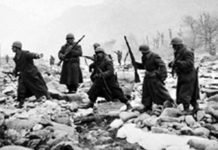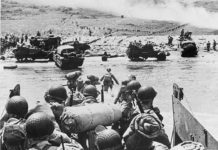Fought on July 21, 1798, the Battle of the Pyramids was fought between the invading French army under the command of Napoleon Bonaparte and local Mamluk warriors, led by Murad and Ibrahim Bey.
Despite it’s title, the pyramids were in fact some ten miles from the actual battlefield, only faintly discernable through the shimmering heat haze. The battle was fought on the western bank of the Nile river, with Cairo – the objective for the French army – on the eastern bank.
Napoleon’s March on Cairo, July 21 1798
Napoleon had commenced his southwards march from the Nile delta two hours before sunrise. By daybreak, his army could make out the rooftops of Cairo in the rising sun and the shimmering expanse of the Nile, with the sides of the pyramids illuminated to the west. Between the Nile and the pyramids, stretching in a line some eight miles long, was the Mamluk army, their weapons and armour glinting in the sun. Napoleon reckoned they faced ‘20,000 Arabs and militia from Cairo, along with 12,000 Mamelukes, agas, sheikhs and other Egyptian notables, on horseback and each having 3 or 4 men on foot to serve them, forming a line of 50,000 men.’ (Modern estimates put the figure at 40,000.)The French army, by contrast, numbered 25,000, but it must be remembered that the Mamluks had divided their forces, with many of them on the eastern bank under the command of Ibrahim Bey.
The French divisions drew near to the village of Embaba – on the western bank – just after 2PM, gorging themselves after their long march on the plentiful watermelons growing in the fields. Many soldiers then faced the ordeal of battle suffering from an acute outbreak of diarrhea.
The Battle of the Pyramids
Facing southwards, Napoleon formed his army into five divisional squares, each under the command of a general, with Desaix on the right flank, followed by Reynier, Dugua, Vial and Bon. He also sent a small detachment to occupy the village of Biktil, to the west. These squares were hollow, with Napoleon’s limited cavalry, baggage and the intellectual savants who had accompanied the expedition taking refuge inside. The men were drawn up in ranks 6 deep, thus enabling the first 3 ranks, as needed, to march forward in column of attack whilst the other 3 ranks maintained a defensive position. Given his lack of cavalry, defensive squares were really the only option Napoleon had when facing the horde of mounted Mamluks which opposed him. He placed his artillery on the corners of the squares and began his advance in echelon, with Desaix’s division – his right flank – in the lead. Pointing at the distant pyramids, Napoleon exhorted his troops on with the legendary saying ‘Soldiers, 40 centuries are looking down on you.’
At 3:30 PM, Murad Bey ordered a massive cavalry charge against Desaix’s division, which was having trouble maintaining it’s formation as it traversed clusters of palms and dried irrigation ditches. The shrieking Mamluk horsemen – some 7 or 8 thousand strong – were 200 paces distant when the order to fire was given. Volley after volley of musketry shredded the charging Mamluks, many of whom wore armour and carried weapons which had not changed since the days of the Crusades. One Corporal Francois recalled that ‘he had never seen men more brave and more determined.’
Successive Mamluk charges ended in failure, as the French squares held firm. Seeing the Mamluk disarray, Napoleon ordered Bon’s division to advance on Embaba, with Vial’s division moving up to cover his flank. Murad Bey ordered his right flank to attack these 2 divisions but the French withstood their charges and then deployed into column and advanced to the outskirts of Embaba.
Ibrahim Bey, watching from the eastern bank, ordered his artillery to open fire on the French in the hopes of driving them away. But he was hampered by the screaming horde of spectators – some believe the entire population of Cairo – making orders impossible to hear. The French drove the Egyptian garrison from Embaba after fierce hand to hand fighting.
Rout of the Mamluk Army
Realising the battle was lost, thousands of Mamluks tried to cross the Nile – many of them drowned, and the crush of panicking civilians trying to get back into Cairo did little to improve matters. Ibrahim Bey fled to the Sinai. Murad Bey gathered what was left of his forces at Giza and departed for Upper Egypt, his final orders being to fire the vast flotilla of boats on the Nile to impede the French crossing. Many civilians thought the French army was burning the city and thousands fled through the north-eastern gate, where they were set upon by shrieking Bedouin warriors intent on pillage. In fact, Bonaparte was not to enter Cairo until July 24.
The battle lasted about 2 hours. The Mamluks lost as much as 3000 of their irreplaceable cavalry and an unknown number of infantry. Napoleon reckoned the Egyptian death toll as high as 10,000, with supposedly 20 – 30 French killed and 260 wounded.
Aftermath
Napoleon had ended 700 years of Mamluk/Turkish dominance in Egypt. However, despite having routed the Mamluk army, due to his paucity of cavalry Napoleon was unable to give chase . Thus the bulk of the Mamluk forces, along with their leaders, escaped to fight another day. The yawning cultural divide, coupled with the destruction of Napoleon’s fleet at the Battle of the Nile by Admiral Horatio Nelson 10 days later, would ensure that the French presence in Egypt was not to last long.
Sources:
- Strathern, Paul; Napoleon in Egypt, London, 2007
- Dellinger, John; Military History magazine, August, 1998








